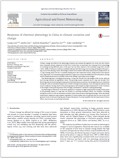| Journal Article |
 |
|
| Article Title | Response of chestnut phenology in China to climate variation andchange | | Author | Liang Guo, Junhu Dai, Sailesh Ranjitkar, Xu Jianchu and Eike Luedeling | | Year | 2013 | | Journal Title | Agricultural and Forest Meteorology | | Institution | Elsevier B.V. | | Volume | 180 | | Pages | 164-172 | | Call Number | JA0526-14 | | Keywords | Chestnut, Climate change, First flowering, Growing season length, Leaf coloring, Partial Least Squares regression |
|
| Abstract: |
Climate change has affected the phenology of plants and animals throughout the world, but few studieshave evaluated climate responses of fruit trees in East Asia. In particular, the response of tree phenologyto warming during different parts of the year has not been explored. We evaluated long-term records(1963–2008) of chestnut (Castanea mollissima Blume) first flowering, leaf coloring and length of the grow-ing season from Beijing, China. Phenological dates were related with daily temperatures (subjected to an11-day running mean) for the 12 months leading up to the respective events, using Partial Least Squares(PLS) regression. For each phenological indicator, regression results identified two relevant phases, duringwhich temperatures were correlated with event timing or growing season length.
First flowering dates in Beijing advanced by 1.6 days per decade over the length of the record, whereasleaf coloring showed no significant trend. The growing season expanded by 4.3 days per decade. Firstflowering was advanced by high temperatures between January and June, but delayed by warm conditionsduring the chill accumulation phase (late October through early January). Leaf coloring was advanced bywarm conditions during most of the growing season, but delayed by high temperatures in fall. Variationin the length of the growing season was strongly correlated to variation in spring phenology.
All phenological indicators of chestnut appeared to respond to high temperatures during certain partsof the growing season in a way that ran counter to currently dominant effects. For instance, warmingduring the period of chill accumulation delayed rather than advanced spring phenology. These secondarytemperature responses may explain responses of certain plants and ecosystems that are not in line withgeneral trends of advanced spring and delayed fall phases. It seems possible that the importance of theseeffects may increase as warming continues. |
|
|
Download file(s): Click icon to download/open file.
|
| |
File Size |
Description |

|
2,314 KB |
Softcopy |
|
|
|
| Viewed in 1134 times. Downloaded in 476 times. |